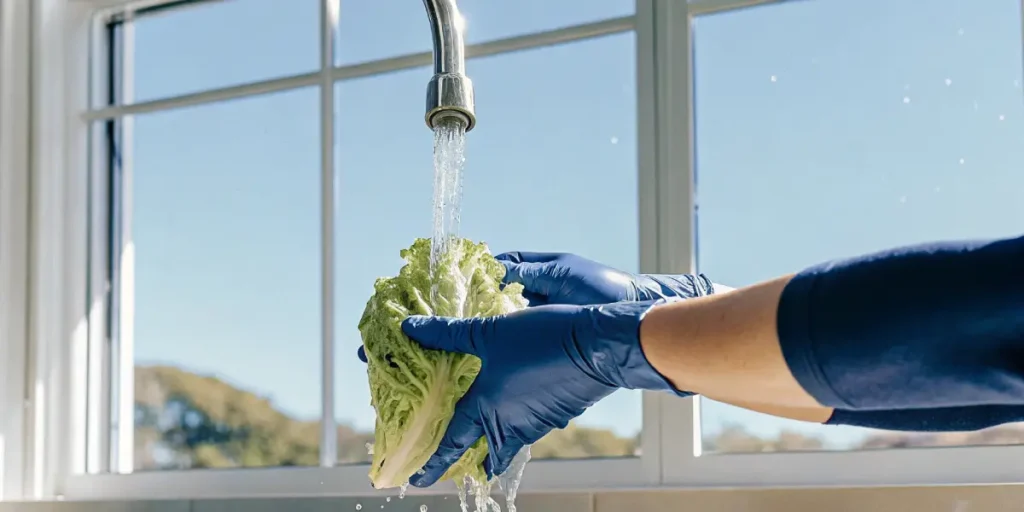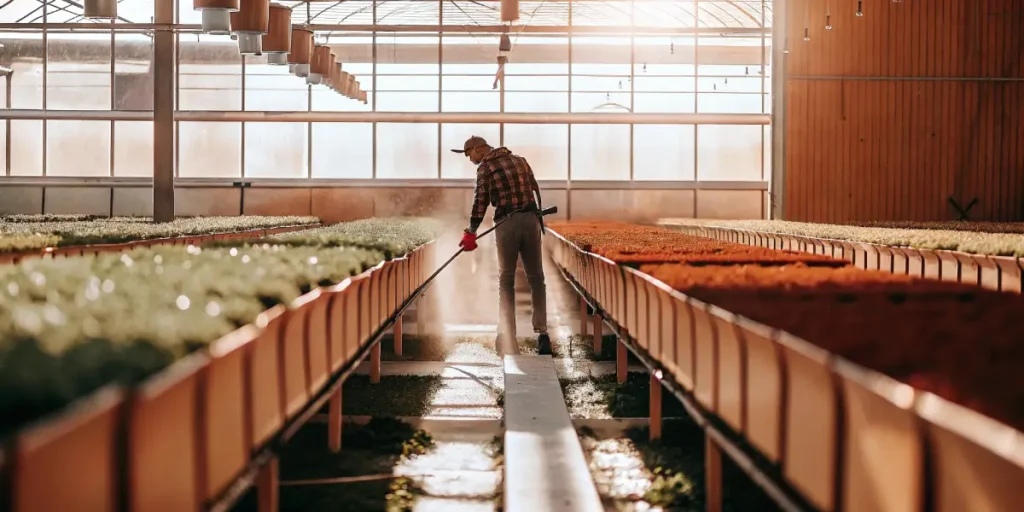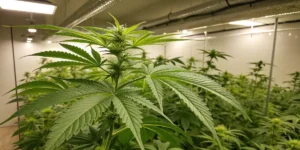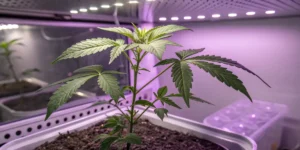Keeping your hydroponic system clean is crucial for healthy plant growth. A clean system prevents the buildup of algae, bacteria, and other harmful pathogens. This ensures your cannabis plants thrive without any unwanted invaders. Whether you’re a newbie or seasoned grower, a clean hydroponic system lays the foundation for success.
Imagine growing a lush batch of Blue Dream only to find your plants struggling due to unseen bacteria. Cleaning regularly helps you avoid these pitfalls. It might seem like a chore, but the benefits are worth it. You’ll have healthier plants and a more bountiful harvest.
Even experienced growers know the importance of a clean system. Just as you wouldn’t cook in a dirty kitchen, growing in a dirty hydroponic setup can lead to problems. By making cleaning a regular part of your routine, you’ll save time and effort in the long run.
Step by Step Hydroponic System Cleaning
Cleaning your hydroponic system isn’t as daunting as it sounds. Break it down into steps, and you’ll have it done in no time. First, gather all necessary supplies. You will need a soft brush, clean cloths, and a gentle cleaning solution like vinegar.
Start by dismantling your system. Take apart the components such as pumps, hoses, and reservoirs. This helps in reaching all the nooks and crannies where grime can accumulate. Work systematically, ensuring nothing is missed.
Once everything is dismantled, begin by rinsing each part with water to remove loose debris. It’s important to be thorough, as even small particles can lead to bigger issues over time. Following this, apply your chosen cleaning solution to scrub the surfaces. This step-by-step hydroponic system cleaning process ensures all areas are addressed.
After cleaning, make sure to inspect each part for any signs of wear or damage. Early detection of issues like cracks or blockages can save you from larger problems later. A comprehensive cleaning routine is the best way to clean hydroponic system components effectively.
Cleaning Hydroponic System with Vinegar
Vinegar is a natural, non-toxic cleaner perfect for hydroponics. It helps remove mineral deposits and residues. Mix one part vinegar with three parts water. Use this solution to scrub the surfaces of your system.
For stubborn stains, soak parts in the vinegar solution for a few hours. This will loosen any buildup, making it easier to wipe away. Rinse thoroughly with clean water to ensure no vinegar remains.
Cleaning hydroponic system with vinegar is not only effective but also environmentally friendly. It’s an ideal choice for those looking to minimize chemical use while maintaining a clean system. Vinegar’s acidity helps break down deposits that might otherwise require harsher solutions.
Additionally, vinegar is readily available and cost-effective, making it accessible for growers of all levels. Its versatility extends beyond cleaning, as it can also serve as a natural deterrent for some pests. By incorporating vinegar into your routine, you’re ensuring a cleaner and safer environment for your plants.
How to Sanitize Hydroponic System
Sanitizing goes beyond cleaning. It ensures any harmful bacteria or algae are completely eliminated. After cleaning, use a mild bleach solution for sanitizing. Mix 1 tablespoon of bleach per gallon of water.
Apply the bleach solution using a spray bottle. Let it sit for about 10 minutes. This contact time is crucial for effective sanitization. Be sure to rinse all parts thoroughly afterward to remove any bleach residue.
Understanding how to sanitize hydroponic system components is key to preventing disease. This step is particularly important in systems experiencing frequent algae or bacterial issues. Ensuring that all parts are sanitized helps maintain a sterile growing environment.
While bleach is effective, it’s crucial to handle it with care. Always wear gloves and ensure adequate ventilation to prevent irritation. For those seeking alternatives, hydrogen peroxide can also be used as a sanitizer, offering a gentler option that still provides thorough disinfection.

How to Clean Hydroponic System Without Chemicals
Some growers prefer chemical-free cleaning methods. Using hydrogen peroxide is an excellent alternative. It breaks down into water and oxygen, leaving no harmful residues.
Mix one part hydrogen peroxide with three parts water. Use this solution to clean all surfaces. It’s safe and effective, providing peace of mind that no harmful chemicals remain.
For those wondering how to clean hydroponic system without chemicals, hydrogen peroxide is a top choice. Its natural breakdown into harmless components makes it an attractive option for organic growers or those with sensitive plants.
Regular use of hydrogen peroxide can also help with oxygenation in your system, promoting better root health. By choosing non-chemical methods, you’re prioritizing both plant health and environmental conservation, ensuring that your system remains both effective and sustainable.
Preventing Future Build-Up
Regular maintenance can prevent future issues. After cleaning, inspect your system for leaks or worn-out parts. Replace any damaged components promptly.
Consider using filtered water to minimize mineral deposits. This simple change can reduce the need for frequent cleaning. Regularly check for algae growth and address it immediately.
Preventing future build-up is all about consistency. Incorporating a regular cleaning schedule into your routine will keep your system in peak condition. This proactive approach minimizes the risk of clogs and ensures optimal nutrient flow.
Additionally, consider adjusting your nutrient solution concentrations to reduce the risk of deposits. By fine-tuning the balance, you can achieve healthier growth while minimizing potential cleaning tasks. This strategic approach helps maintain a cleaner system with minimal effort.
Choosing the Right Strains
When using a hydroponic system, some strains thrive better than others. Strains like OG Kush are known for their resilience and suitability for hydroponic growth.
Global Green Genetics offers a variety of seeds perfect for hydroponics. Consider strains that have been tested and proven to perform well in such systems.
Choosing the right strains ensures you’re making the most of your clean hydroponic environment. Strains with robust genetics are more likely to thrive, providing you with higher yields and healthier plants. This consideration is especially important for those new to hydroponics.
Researching strains that have been specifically bred for hydroponic conditions can give you a head start. Look for recommendations from other growers and consider strains known for strong root systems and adaptability. This strategic choice complements your efforts in maintaining a clean and efficient system.

FAQs
How often should I clean my hydroponic system?
Cleaning frequency can depend on the size and complexity of your system. Generally, it’s a good idea to clean your system every two weeks. This helps prevent the buildup of any unwanted materials.
For larger systems, it might be necessary to clean more frequently. Regular inspection will guide you. The cleaner your system, the healthier your cannabis plants will be.
Understanding how often to clean is crucial for maintaining system efficiency. Over time, debris and deposits can accumulate, impacting plant health. Regular cleaning ensures that your system remains in optimal condition.
Even in smaller systems, neglecting cleaning can lead to significant issues. By setting a consistent schedule, you can avoid potential problems and ensure that your plants receive the best possible growing conditions.
Can I use household cleaning products?
Avoid using harsh household cleaners. These can leave residues harmful to your plants. Stick to safe options like vinegar or hydrogen peroxide.
Household products often contain chemicals that can seep into your water supply. This can affect plant health and yield. It’s best to use products specifically recommended for hydroponics.
While the convenience of household cleaners might be tempting, their use can introduce risks to your hydroponic system. It’s important to prioritize plant safety by choosing appropriate cleaning methods.
By understanding the impact of different cleaning agents, you can make informed decisions that benefit your plants. Opt for solutions that are gentle yet effective, ensuring that your hydroponic system remains a safe environment for growth.
Is cleaning necessary for small systems?
Yes, even small systems require regular cleaning. Smaller setups can quickly become clogged or contaminated. Regular maintenance ensures everything runs smoothly.
No system is too small to ignore. By maintaining a clean environment, you’re promoting optimal growth conditions for strains like Sour Diesel.
Small systems have their own unique challenges, often requiring more frequent attention. Due to their compact nature, even minor issues can escalate quickly if not addressed.
Regular cleaning in smaller systems helps prevent problems before they start. By being diligent, you can maintain a productive and healthy growing environment, ensuring your plants reach their full potential.
What’s the best way to clean hydroponic system parts?
Dismantle each part to clean effectively. Use a brush to scrub hard-to-reach areas. Rinse thoroughly with clean water after using any cleaning solution.
Pay extra attention to parts like pumps and hoses. These are common places for buildup. Ensuring these parts are clean will improve your system’s efficiency.
The best way to clean hydroponic system parts involves a methodical approach. By taking the time to dismantle each component, you can ensure a comprehensive clean that addresses all potential problem areas.
Using the right tools, such as brushes and gentle cleaners, is essential for effective maintenance. By investing in quality cleaning equipment, you’re ensuring that your hydroponic system remains in top condition for the long term.
Can I clean my system while plants are growing?
It’s best to clean between growing cycles. This prevents any disruption to plant growth. However, if necessary, you can clean individual parts carefully.
Ensure that plants are not exposed to any cleaning agents. Work gently around your plants to avoid stress. This maintains a healthy growing environment.
Cleaning during growing cycles requires careful planning and execution. By focusing on individual parts, you can maintain system cleanliness without disrupting plant growth.
In emergencies, prioritize areas that impact water flow or nutrient delivery. By addressing these concerns promptly, you can maintain a healthy environment while minimizing plant stress. Always ensure that cleaning activities are conducted with plant safety in mind.





